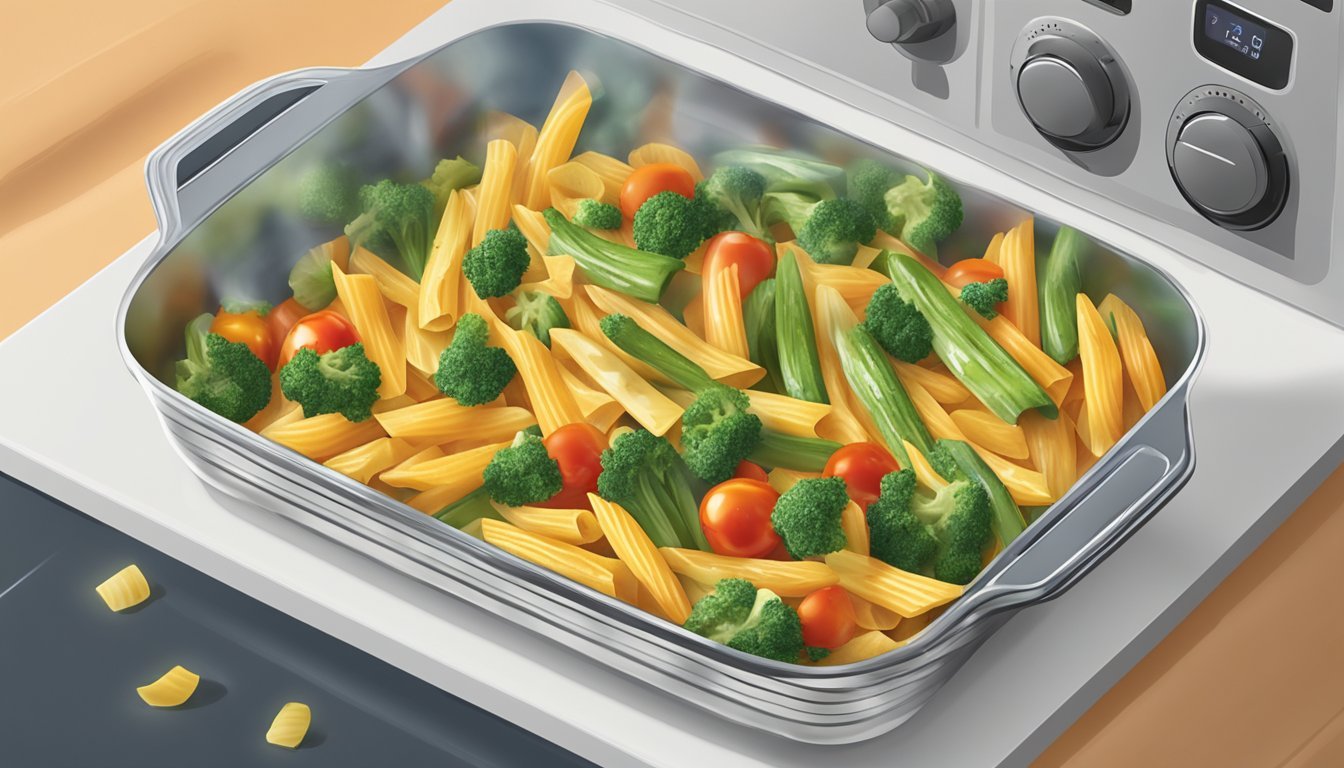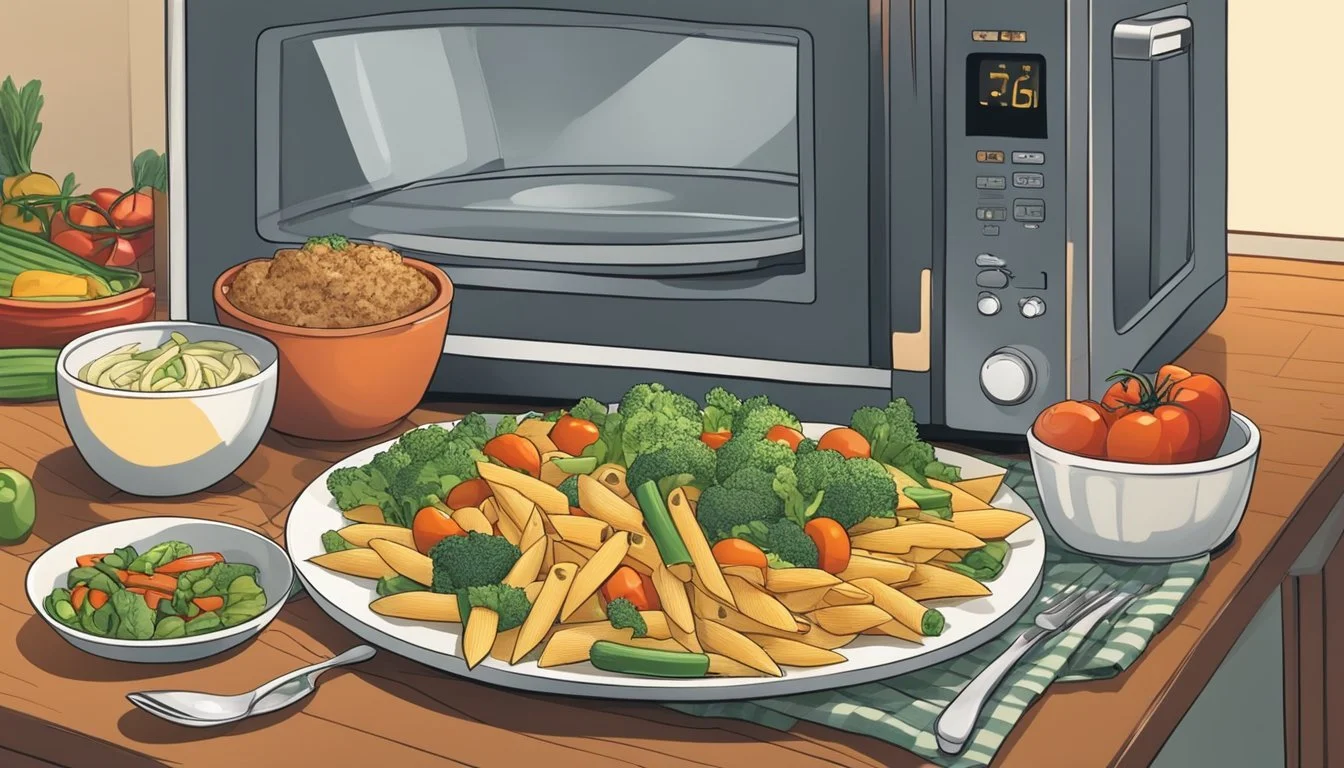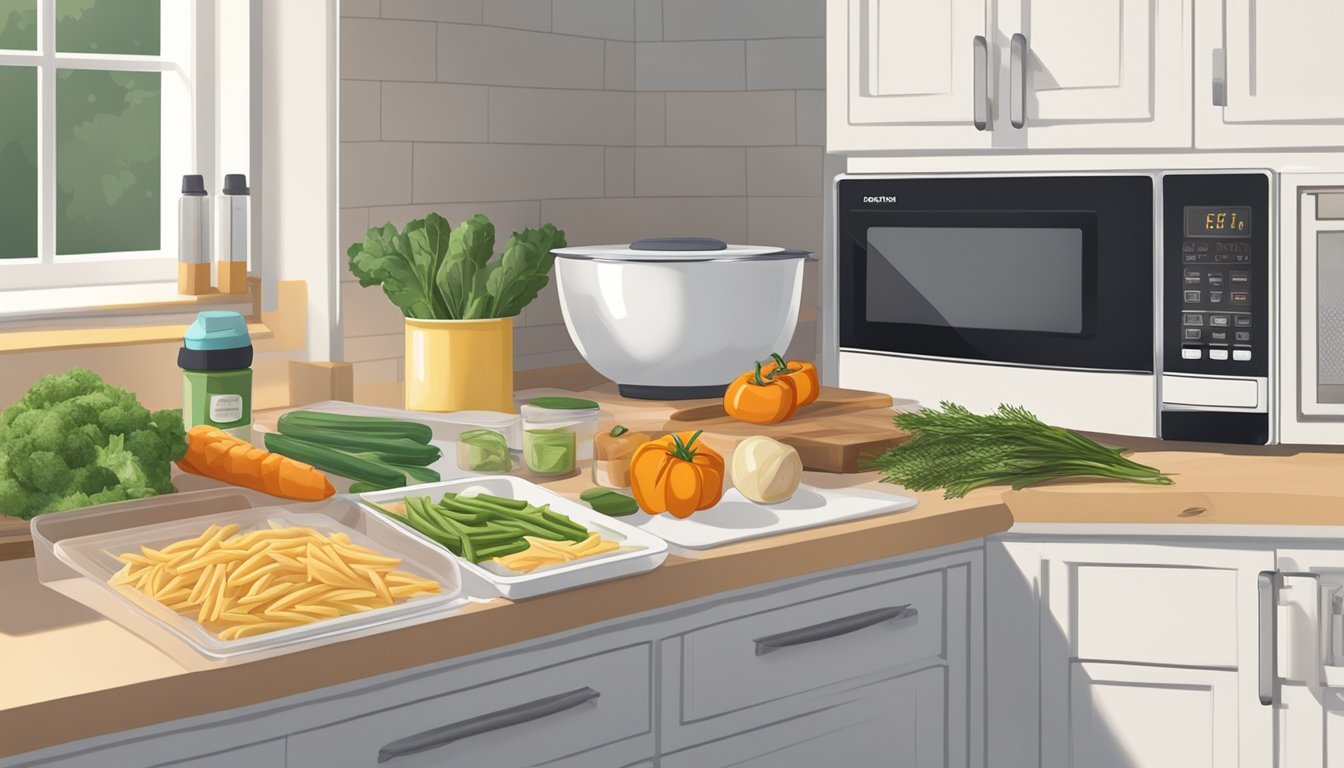Best Way to Reheat Baked Penne with Roasted Vegetables
Ensuring Perfect Texture Every Time
Baked penne with roasted vegetables is a dish that many relish for its comforting flavors and rich texture. Ensuring the pasta and vegetables maintain their distinct textures upon reheating is crucial for enjoying the meal as if it were fresh out of the oven. The key lies in understanding the nuances of temperature control and reheating methods that can revive the dish without compromising its initial appeal.
Traditional ovens and toaster ovens are often preferred for reheating for their ability to heat food evenly. While microwave ovens offer convenience and speed, they can sometimes lead to soggy pasta and limp vegetables, which detracts from the dish's original texture and taste. The challenge then becomes selecting a reheating technique that not only warms the food thoroughly but also revives the roasted vegetables to their original, crisply baked state.
Careful consideration of factors such as oven temperature, cookware, and timing ensures that each component of the baked penne and roasted vegetables is heated to its optimal state. A delicate balance is required to avoid overcooking, which can turn pasta mushy and vegetables too soft. Employing the right approach turns the simple act of reheating into an opportunity to savour the baked penne with roasted vegetables as it was meant to be enjoyed.
Understanding the Importance of Proper Reheating
When one reheats leftovers, particularly a dish like baked penne with roasted vegetables, their priority is often to retain the quality and flavor while ensuring safety. The texture of roasted vegetables can become unpleasantly soft and the pasta may turn mushy if reheated incorrectly. Therefore, proper reheating is crucial for both sensory appeal and nutrient preservation.
Flavor and Texture: Maintaining the integrity of the flavor and texture of the vegetables and pasta should be a priority. Reheating should be done just enough to ensure that the dish is warmed through but not overcooked.
Safety Considerations: Reheating to an adequate temperature is essential to eliminate potential bacteria that can cause foodborne illnesses. One should thoroughly reheat the dish to an internal temperature of 165 degrees Fahrenheit, as recommended by food safety guidelines.
Aspect Why It's Important Flavor Retain the original taste of the dish Texture Preserve the desired consistency Nutritious Value Avoid nutrient degradation Safety Ensure the dish is safe to consume
Quality Preservation: It’s also important to consider that vegetables and pasta in a dish such as baked penne are prone to lose their nutritious value when exposed to high heat for prolonged periods. Hence, reheating should be done swiftly to minimize the potential nutrient loss.
In summary, proper reheating is key to enjoying baked penne with roasted vegetables in terms of its flavor, texture, and nutritious value, while also ensuring that the quality of the leftovers is maximized and all safety standards are met.
Preparing Baked Penne and Roasted Vegetables for Reheating
Proper preparation is crucial for reheating baked penne with roasted vegetables to ensure they retain their texture and flavor. Follow these steps to prepare your leftovers for reheating.
Allow the leftover roasted vegetables and baked penne to cool to room temperature before storing. This prevents condensation which can make the dish soggy.
Transfer the leftovers into an airtight container to keep out moisture and other contaminants.
Store them in the refrigerator if you plan to reheat within the next few days. Keeping them cold inhibits bacterial growth and maintains quality.
Freezing for Later Use:
If you don't plan to eat the leftovers soon, wrap them with foil or parchment paper, then place inside freezer bags to prevent freezer burn.
Label the bags with the date to ensure you use them within an optimal timeframe, typically within three months for best quality.
Before Reheating:
Decide whether to use an oven or microwave based on your preference and convenience. Each reheating method may require different preparation.
For oven reheating, preheat the oven in advance to ensure an even reheating process. It also helps in crisping up the vegetables.
Remove the baked penne and vegetables from the fridge about 20 minutes prior to reheating to let them come to room temperature, which can reduce reheating time and help with heating evenly.
Reheating Techniques for Optimal Texture and Flavor
To maintain the savory quality of baked penne with roasted vegetables, employing proper reheating methods is key. The goal is to ensure the penne is hot throughout without compromising the crispness of the vegetables or the dish's overall flavor.
Oven Reheating
One of the most effective ways to reheat baked penne with roasted vegetables is in the oven. Preheat your oven to 350°F (175°C). Place the dish on a baking sheet lined with foil, optionally drizzle with a bit of olive oil for freshness, and cover with foil to prevent drying out. Heat for 10-15 minutes, checking periodically. The consistent heat allows for even reheating, helping to keep the vegetables’ texture close to their original state.
Preparation: Preheat oven, line baking sheet with foil
Temperature: 350°F (175°C)
Time: 10-15 minutes
Additional Tips: Optional olive oil drizzle, cover with foil
Stovetop Reheating
Reheating on the stovetop using a skillet over medium heat can also preserve the texture and amplify flavors. Add a small amount of butter or oil to prevent sticking and add a bit of crispness to the vegetables. Stir occasionally to ensure even heating and prevent burning. This method can refresh the dish, especially if you're aiming for slightly golden edges on the veggies.
Tool: Skillet
Heat: Medium
Additional: Small amount of butter or oil
Microwave Reheating
Although not ideal for optimal texture, the microwave offers a quick and convenient reheating option. Place a single serving of the baked penne and vegetables on a microwave-safe plate. To avoid dryness, add a sprinkle of water before covering with a microwave-safe lid or damp paper towel. Heat in short intervals, stirring between each to prevent overheating and ensure even warmth.
Container: Microwave-safe plate
Moisture: Sprinkle of water
Covering: Microwave-safe lid or damp paper towel
Heating Intervals: Short, with stirring
Using an Air Fryer for Reheating
An air fryer can be utilized for reheating to recapture the crispness of the roasted vegetables. Preheat the air fryer to 350°F (175°C). Place the baked penne with roasted veggies in the basket, ensuring space for air circulation. Reheat for a few minutes, checking regularly. The quick circulation of hot air will help to revitalize the crispy texture without overcooking.
Preparation: Preheat air fryer
Temperature: 350°F (175°C)
Time: A few minutes, check regularly
Benefits: Quick and crisp reheating, easy cleanup
Culinary Tips for Enhancing the Reheated Dish
When reheating baked penne with roasted vegetables, applying a few culinary tips can greatly improve the dish's flavor and texture. These tips focus on seasoning adjustments, the addition of fresh ingredients, and serving suggestions that elevate the overall dining experience.
Seasoning Adjustments
The process of reheating can dull the flavors in a dish. To counteract this, they can make small but impactful changes to the seasoning. Initially, a liberal pinch of salt and a crack of black pepper can bring back the zesty taste. A light drizzle of olive oil can add richness, while a pinch of garlic powder or a sprinkling of fresh herbs such as basil or oregano can enhance the depth and freshness of the flavors.
Recommended seasoning adjustments:
Salt: 1/4 teaspoon or to taste
Black Pepper: 1/8 teaspoon or to taste
Olive Oil: 1 teaspoon
Garlic Powder: 1/8 teaspoon
Fresh Herbs: 1 tablespoon, chopped
Adding Fresh Ingredients
Incorporating fresh ingredients after reheating can provide textural contrast and vibrant flavors. They can consider adding diced tomatoes for acidity, sautéed mushrooms for umami, or a handful of fresh spinach for a healthy touch. This not only adds to the nutritional value but also reintroduces a fresh element to the dish that complements the existing roasted vegetables like zucchini, onions, and bell peppers.
Fresh ingredients to consider:
Diced Fresh Tomatoes: 1/2 cup
Sautéed Mushrooms: 1/4 cup
Fresh Spinach: 1 cup
Serving Recommendations
For an appealing presentation, they should serve the reheated penne on a warm plate with an extra ladle of sauce to ensure the pasta is moist. To round off the meal, they could include a side salad dressed with a vinaigrette, which would introduce a crisp and acidic element to balance the rich flavors of the baked penne and roasted veggies.
Serve with:
Additional Sauce: 1/4 cup
Side Salad: 1 serving
Vinaigrette Dressing: 2 tablespoons
Safety Considerations When Reheating Food
When reheating leftovers such as baked penne with roasted vegetables, maintaining a safe temperature is crucial to prevent foodborne illnesses. Food should be reheated to an internal temperature of at least 165 °F, as recommended by food safety authorities. Using a food thermometer can ensure that this temperature is reached, effectively killing harmful bacteria that may have developed during storage.
Proper storage plays a significant role in keeping leftovers safe. Leftover dishes should be refrigerated within two hours of cooking to prevent bacterial growth. Signs of spoilage include bad smell, change in texture, or the presence of mold. If any of these signs are present, the food should be discarded.
Key Points to Remember:
Store Properly: Refrigerate at or below 40 °F.
Heat Thoroughly: Reach an internal temperature of 165 °F.
Check for Spoilage: Discard any food with mold or a bad smell.
Leftovers should be stored in airtight containers to maintain their quality and prevent contamination. Ideally, reheating should be done once, as the more times a meal is cooled and reheated, the higher the risk of bacterial growth.
With meal prep, it's best to portion the food properly before storing it. This allows individuals to reheat only what they plan to consume, reducing the risk of repeatedly reheating and cooling the same batch of food, which can lead to an increased risk of bacteria proliferation.
In summary, to ensure safety and quality, leftovers like baked penne with roasted vegetables should be stored and reheated with care. Keeping a close eye on temperature and storage conditions can aid in preventing foodborne illnesses and ensuring a safe and enjoyable meal.
Storing Leftovers for Future Meals
Proper storage techniques are essential for maintaining the quality and safety of leftover baked penne with roasted vegetables. Utilizing correct refrigeration and freezing methods ensures that the textures and flavors are preserved for future meals.
Refrigerating Leftovers
To refrigerate leftover baked penne with roasted vegetables, one should transfer the food into a shallow, airtight container. This not only saves space but also helps cool the dish more rapidly, minimizing the risk of bacterial growth. Leftover vegetables should be stored separately to prevent them from becoming soggy. These steps should be performed promptly:
Transfer: Separate the leftover roasted vegetables from penne.
Cool: Bring the temperature down before sealing to avoid condensation.
Freezing and Reheating
For longer-term storage, freezing is an effective option. Leftover vegetables and penne should be spread out on a baking sheet and placed in the freezer initially to prevent clumping. Once frozen, they can be transferred to freezer bags or wrapped in aluminum foil for optimal storage. When freezing soups that accompanied the dish, use individual airtight containers to avoid freezer burn. To reheat:
Thaw overnight in the refrigerator.
Reheat in the oven or microwave, stirring occasionally to maintain even temperatures.
Using these methods, one can successfully store and later enjoy their leftover baked penne with roasted vegetables without compromising on quality.
Pairing Reheated Penne with Roasted Vegetables With Other Dishes
When incorporating reheated penne with roasted vegetables into a meal, it's important to consider complementary dishes that can complete the dining experience while maintaining a healthy balance. Careful selection of soups, salads, and sauces can create a harmonious meal that is also suitable for meal prep scenarios.
Soups: A light broth-based soup, such as a minestrone or a chicken vegetable soup, makes an excellent starter. The soup should not overpower the penne's flavors but act as a palate cleanser.
Soup Type Characteristics Minestrone Rich with vegetables, light broth Chicken Soup Clear broth, subtle flavors
Salads: A crisp salad complements the soft texture of the baked penne. Opt for a salad with a vinaigrette dressing to counterbalance the richness of the roasted vegetables.
Salad Components Description Mixed Greens Base for salads, high in nutrients Vinaigrette Light dressing, adds a zesty twist
Sauces: If the penne lacks moisture after reheating, a small amount of fresh sauce can be drizzled on top. One can choose a tomato-based sauce or a light olive oil and herbs combination for extra flavor without compromising health.
Sauce Choice Purpose Tomato Sauce Adds moisture, fresh taste Olive Oil & Herbs Enhances flavor, maintains health
In terms of meal prep, reheated baked penne with roasted vegetables can be stored and served with these side dishes throughout the week, ensuring a balance of flavors and nutrition in every meal.
Troubleshooting Common Reheating Problems
When reheating baked penne with roasted vegetables, individuals often encounter several issues that can affect the dish's texture and taste. This section addresses common problems and suggests solutions to ensure a satisfying result.
Soggy Pasta:
Cause: Excessive moisture from steam.
Solution: Reheat in an oven at 350°F on a baking dish, uncovered, to allow moisture to escape.
Overcooked Veggies:
Cause: High heat for too long.
Solution: Reheat vegetables at a moderate temperature (350°F) and check for doneness every 5 minutes to prevent them from becoming mushy.
Problem Cause Solution Soggy Pasta Excessive moisture Reheat uncovered Mushy Veggies Overcooking Moderate heat; Check often
Uneven Heating:
Cause: Microwaving or improper oven placement.
Solution: Stir pasta and rotate vegetables halfway through reheating in the microwave or ensure they are spread in an even layer in the oven.
Burnt Edges:
Cause: Too high a temperature or too close to the heating element.
Solution: Use a lower temperature and make sure to cover with aluminum foil to protect the food from direct heat.
For the best texture, individuals should aim for a crisp finish on the vegetables and avoid stirring too often, which can lead to breaking the pasta. Patience and careful attention to reheating methods will help maintain the distinct textures of baked penne and roasted vegetables.
Advantages of Preparing Meals in Advance
Preparing meals in advance, often known as meal prep, offers several benefits that align with the needs of a busy lifestyle. It is particularly effective for dishes like baked penne with roasted vegetables, which hold up well when reheated.
Time-Saving: One of the most significant advantages is the time saved. By dedicating a few hours to meal prep, individuals can have meals ready for the week, eliminating the daily time spent preparing and cooking. This proves immensely useful for those with tight schedules.
Convenience: Meal prep also ensures convenience. Having a healthy meal like baked penne with roasted vegetables ready in the refrigerator means just a quick reheat away from enjoying a nutritious dinner. It suits those who prefer not to cook daily.
Healthy Choices: The practice supports making healthier food choices. When meals are prepared ahead of time, individuals are less likely to resort to fast food or processed options. Advance preparation means control over ingredients, which favors a balanced diet.
Managing Leftovers: Utilizing leftovers efficiently is another key aspect. A well-prepared baking dish can yield several portions, limiting food wastage and providing subsequent meals that maintain quality and taste when reheated correctly.
Consistency in Meals: For those aiming to adhere to a specific dietary program, meal prep encourages consistency. Preparing meals like baked penne with roasted vegetables in advance helps to maintain portion control and ensures that dietary goals are met.
Advantages Positive Impact Time-Saving Reduces daily cooking time Convenience Quick and easy access to meals Healthy Choices Encourages nutritious eating habits Leftovers Optimizes food usage Consistency Helps maintain dietary discipline
In conclusion, the principles of meal prep offer a strategic approach to dining that saves time, promotes health, optimizes leftovers, and simplifies the daily routine with the convenience of ready-to-go meals.






